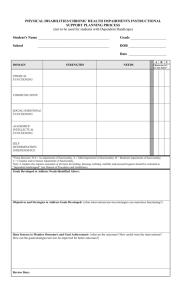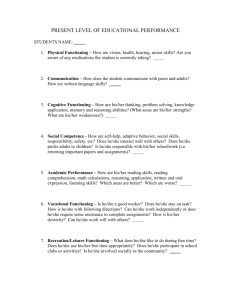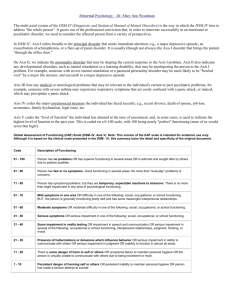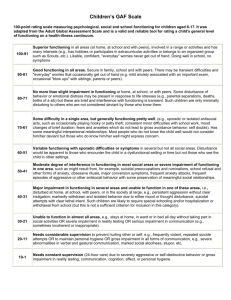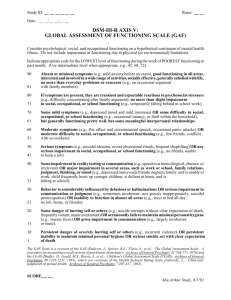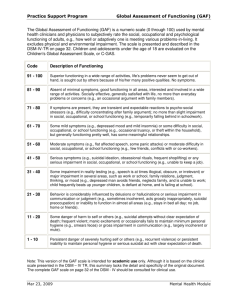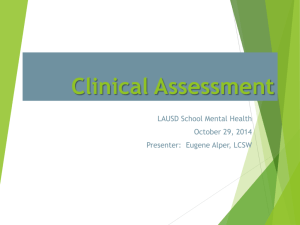Major Psych Diseases - Website of Neelay Gandhi
advertisement
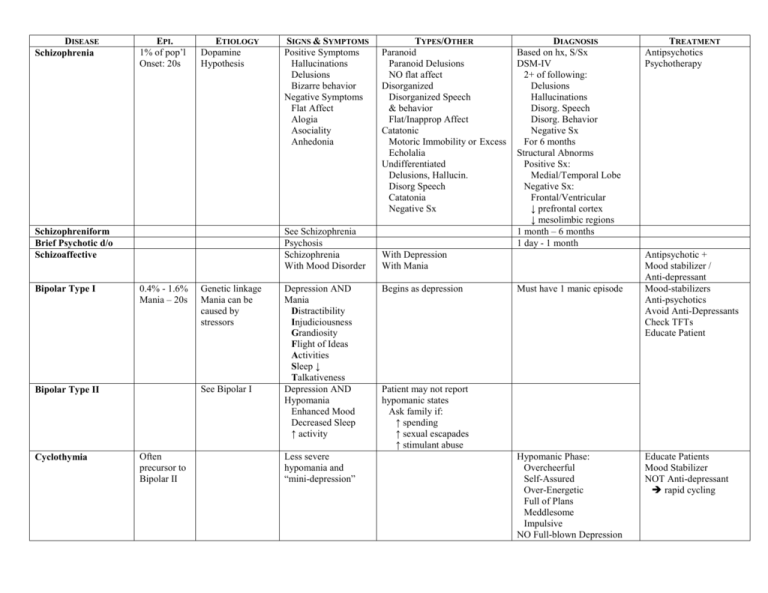
DISEASE Schizophrenia EPI. 1% of pop’l Onset: 20s ETIOLOGY Dopamine Hypothesis See Schizophrenia Psychosis Schizophrenia With Mood Disorder Schizophreniform Brief Psychotic d/o Schizoaffective Bipolar Type I 0.4% - 1.6% Mania – 20s Genetic linkage Mania can be caused by stressors See Bipolar I Bipolar Type II Cyclothymia SIGNS & SYMPTOMS Positive Symptoms Hallucinations Delusions Bizarre behavior Negative Symptoms Flat Affect Alogia Asociality Anhedonia Often precursor to Bipolar II Depression AND Mania Distractibility Injudiciousness Grandiosity Flight of Ideas Activities Sleep ↓ Talkativeness Depression AND Hypomania Enhanced Mood Decreased Sleep ↑ activity Less severe hypomania and “mini-depression” TYPES/OTHER Paranoid Paranoid Delusions NO flat affect Disorganized Disorganized Speech & behavior Flat/Inapprop Affect Catatonic Motoric Immobility or Excess Echolalia Undifferentiated Delusions, Hallucin. Disorg Speech Catatonia Negative Sx DIAGNOSIS Based on hx, S/Sx DSM-IV 2+ of following: Delusions Hallucinations Disorg. Speech Disorg. Behavior Negative Sx For 6 months Structural Abnorms Positive Sx: Medial/Temporal Lobe Negative Sx: Frontal/Ventricular ↓ prefrontal cortex ↓ mesolimbic regions 1 month – 6 months 1 day - 1 month With Depression With Mania Begins as depression Must have 1 manic episode TREATMENT Antipsychotics Psychotherapy Antipsychotic + Mood stabilizer / Anti-depressant Mood-stabilizers Anti-psychotics Avoid Anti-Depressants Check TFTs Educate Patient Patient may not report hypomanic states Ask family if: ↑ spending ↑ sexual escapades ↑ stimulant abuse Hypomanic Phase: Overcheerful Self-Assured Over-Energetic Full of Plans Meddlesome Impulsive NO Full-blown Depression Educate Patients Mood Stabilizer NOT Anti-depressant rapid cycling DISEASE Major Depressive Disorder EPI. M: 5-12% F: 10-25% Onset: 29 yr Dysthymic Disorder 3% of pop’l ETIOLOGY Genetic loading Biochemical Biogenic amine 5HT, NE, DA Dementia Alzheimer’s Huntington’s Ch. Parkinson’s Vascular Hydrocephalus Delirium Extra-CNS Metabolic Infections Medications Illicit Drugs Organic Causes SIGNS & SYMPTOMS Sleep ↓ or ↑ Interest ↓ Guilt Energy ↓ Concentration ↓ Appetite Psychomotor ↓ Suicide TYPES/OTHER With psychotic features Congruent v. incongruent With Melancholic features With Atypical features With Post-Partum onset With Seasonal Pattern With Catatonic features DIAGNOSIS At least 5 symptoms Lasting at least 2 weeks Must disrupt functioning See Depression Double Depression Co-morbidity with MDD At least 2 symptoms present more than not for two years Clinical Diagnosis Rule out DDx ESR, CBC, CMP, TFTs B12, Folate, UA, UCx, CXR, CT head EEG Early Personality Changes ↓ social skills ↓ interests Agitation Late Memory Loss Personality – MDD Anxiety, sloppy, Belligerent Loss of Orientation ↓ Cognition ↓ Judgement Psychoses ↓ Speech ↓ Consciousness Confusion Attention Deficit Perceptual Dist. Disorientation Memory Impairment Disorientation Incoherence Fluctuations Acute Onset Confusion With symptoms TREATMENT TCAs MAOIs SSRIs Atypical Bupropion (Wellbutrin) Mirtazapine (Remeron) Trazodone (Desyrel) Venlafaxine (Effexor) ECT Psychotherapy Supportive Symptomatic Agitation Anti-psychotic Anxiety Ativan Chronic Agitation SSRIs Specific AChE Inhibitors Aricept, Exelon, Reminyl NMDA Receptor Namenda Treat Cause Supportive Patient Safety Use antipsychotics for psychoses/agitiation Notes Axis I: Axis II: Axis III: Axis IV Axis V: Clinical (Mental) Disorder Personality Disorders and Mental Retardation General Medical Condition Psychosocial and Environmental Factors Global Assessment of Functioning 100 - 91 ... Superior functioning in a wide range of activities, life's problems never seem to get out of hand, is sought out by others because of his or her many positive qualities. No symptoms. 90 - 81 ... Absent or minimal symptoms (e.g., mild anxiety before an exam), good functioning in all areas, interested and involved in a wide range of activities, socially effective generally satisfied with life, no more than everyday problems or concerns (e.g., an occasional argument with family members). 80 - 71 ... If symptoms are present, they are transient and expectable reactions to psychosocial stressors (e.g., difficulty concentrating after family argument); no more than slight impairment in social, occupational, or school functioning (e.g., temporarily falling behind at work or in school work). 70 - 61 ... Some mild symptoms (e.g., depressed mood and mild insomnia) or some difficulty in social, occupational, or school functioning (e.g., occasional truancy, or theft within the household), but generally functioning pretty well, has some meaningful interpersonal relationships. 60 - 51 ... Moderate symptoms (e.g., flat effect and circumstantial speech, occasional panic attacks) or moderate difficulty in social, occupational, or school functioning (e.g., few friends, conflicts with peers or coworkers). 50 - 41 ... Serious symptoms (e.g., suicidal ideation, severe obsessional rituals, frequent shoplifting) or any serious impairment in social, occupational, or school functioning (e.g., no friends, unable to keep a job). 40 - 31 ... Some impairment in reality testing or communication (e.g., speech is at times illogical, obscure, or irrelevant) or major impairment in several areas, such as work or school, family relationships, judgment, thinking, or mood (e.g., depressed, avoids friends, neglects family, unable to work, child frequently beats up younger children, defiant, falling behind in school). 30 - 21 ... Behavior is considerably influenced by delusions or hallucinations or serious impairment in communication or judgment (e.g., sometimes incoherent, acts grossly inappropriately, suicidal preoccupation) or inability to function in almost all areas (e.g., stays in bed all day, no job, home, or friends). 20 - 11 ... Some danger of hurting self or others (e.g., suicide attempts without clear expectation of death, frequently violent, manic excitement) or occasionally fails to maintain minimal personal hygiene (e.g., smears feces) or gross impairment in communication (e.g., largely incoherent or mute). 10 - 1 ... Persistent danger of severely hurting self or others (e.g., recurrent violence) or persistent inability to maintain minimal personal hygiene or serious suicidal act with clear expectation of death. 0 ... Inadequate information.
